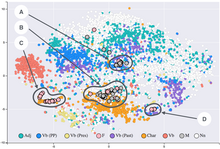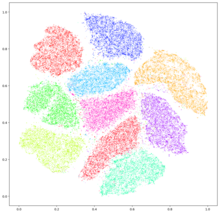
Back Incrustación de vecinos estocásticos distribuidos en t (t-SNE) Spanish T-sne کاهش ابعاد داده Persian Algorithme t-SNE French T-SNE HE T-distributed stochastic neighbor embedding Italian T分布型確率的近傍埋め込み法 Japanese T-분포 확률적 임베딩 Korean Стохастическое вложение соседей с t-распределением Russian การฝังเพื่อนบ้านแบบเฟ้นสุ่มแจกแจง t Thai T-розподілене вкладення стохастичної близькості Ukrainian


| Part of a series on Statistics |
| Data and information visualization |
|---|
| Major dimensions |
| Important figures |
| Information graphic types |
| Related topics |
t-distributed stochastic neighbor embedding (t-SNE) is a statistical method for visualizing high-dimensional data by giving each datapoint a location in a two or three-dimensional map. It is based on Stochastic Neighbor Embedding originally developed by Geoffrey Hinton and Sam Roweis,[1] where Laurens van der Maaten and Hinton proposed the t-distributed variant.[2] It is a nonlinear dimensionality reduction technique for embedding high-dimensional data for visualization in a low-dimensional space of two or three dimensions. Specifically, it models each high-dimensional object by a two- or three-dimensional point in such a way that similar objects are modeled by nearby points and dissimilar objects are modeled by distant points with high probability.
The t-SNE algorithm comprises two main stages. First, t-SNE constructs a probability distribution over pairs of high-dimensional objects in such a way that similar objects are assigned a higher probability while dissimilar points are assigned a lower probability. Second, t-SNE defines a similar probability distribution over the points in the low-dimensional map, and it minimizes the Kullback–Leibler divergence (KL divergence) between the two distributions with respect to the locations of the points in the map. While the original algorithm uses the Euclidean distance between objects as the base of its similarity metric, this can be changed as appropriate. A Riemannian variant is UMAP.
t-SNE has been used for visualization in a wide range of applications, including genomics, computer security research,[3] natural language processing, music analysis,[4] cancer research,[5] bioinformatics,[6] geological domain interpretation,[7][8][9] and biomedical signal processing.[10]
For a data set with n elements, t-SNE runs in O(n2) time and requires O(n2) space.[11]
- ^ Hinton, Geoffrey; Roweis, Sam (January 2002). Stochastic neighbor embedding (PDF). Neural Information Processing Systems.
- ^ van der Maaten, L.J.P.; Hinton, G.E. (Nov 2008). "Visualizing Data Using t-SNE" (PDF). Journal of Machine Learning Research. 9: 2579–2605.
- ^ Gashi, I.; Stankovic, V.; Leita, C.; Thonnard, O. (2009). "An Experimental Study of Diversity with Off-the-shelf AntiVirus Engines". Proceedings of the IEEE International Symposium on Network Computing and Applications: 4–11.
- ^ Hamel, P.; Eck, D. (2010). "Learning Features from Music Audio with Deep Belief Networks". Proceedings of the International Society for Music Information Retrieval Conference: 339–344.
- ^ Jamieson, A.R.; Giger, M.L.; Drukker, K.; Lui, H.; Yuan, Y.; Bhooshan, N. (2010). "Exploring Nonlinear Feature Space Dimension Reduction and Data Representation in Breast CADx with Laplacian Eigenmaps and t-SNE". Medical Physics. 37 (1): 339–351. doi:10.1118/1.3267037. PMC 2807447. PMID 20175497.
- ^ Wallach, I.; Liliean, R. (2009). "The Protein-Small-Molecule Database, A Non-Redundant Structural Resource for the Analysis of Protein-Ligand Binding". Bioinformatics. 25 (5): 615–620. doi:10.1093/bioinformatics/btp035. PMID 19153135.
- ^ Balamurali, Mehala; Silversides, Katherine L.; Melkumyan, Arman (2019-04-01). "A comparison of t-SNE, SOM and SPADE for identifying material type domains in geological data". Computers & Geosciences. 125: 78–89. Bibcode:2019CG....125...78B. doi:10.1016/j.cageo.2019.01.011. ISSN 0098-3004. S2CID 67926902.
- ^ Balamurali, Mehala; Melkumyan, Arman (2016). Hirose, Akira; Ozawa, Seiichi; Doya, Kenji; Ikeda, Kazushi; Lee, Minho; Liu, Derong (eds.). "t-SNE Based Visualisation and Clustering of Geological Domain". Neural Information Processing. Lecture Notes in Computer Science. 9950. Cham: Springer International Publishing: 565–572. doi:10.1007/978-3-319-46681-1_67. ISBN 978-3-319-46681-1.
- ^ Leung, Raymond; Balamurali, Mehala; Melkumyan, Arman (2021-01-01). "Sample Truncation Strategies for Outlier Removal in Geochemical Data: The MCD Robust Distance Approach Versus t-SNE Ensemble Clustering". Mathematical Geosciences. 53 (1): 105–130. Bibcode:2021MaGeo..53..105L. doi:10.1007/s11004-019-09839-z. ISSN 1874-8953. S2CID 208329378.
- ^ Birjandtalab, J.; Pouyan, M. B.; Nourani, M. (2016-02-01). "Nonlinear dimension reduction for EEG-based epileptic seizure detection". 2016 IEEE-EMBS International Conference on Biomedical and Health Informatics (BHI). pp. 595–598. doi:10.1109/BHI.2016.7455968. ISBN 978-1-5090-2455-1. S2CID 8074617.
- ^ Pezzotti, Nicola. "Approximated and User Steerable tSNE for Progressive Visual Analytics" (PDF). Retrieved 31 August 2023.